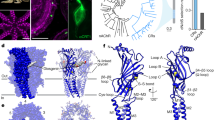Abstract
OCTOPAMINE is a phenylethylamine synthesised by β-hydroxylation of tyramine and differs from noradrenaline in lacking one hydroxyl group on the phenyl ring. Although Aplysia nervous tissue, like that of most molluscs, contains little or no noradrenaline1,2, it has between 0.20 and 1.85 pmol octopamine per mg of tissue in the various ganglia. Individual identified neurones also contain detectable octopamine and in neurone R14 it reaches 1.5×10−4 M (ref. 2). Although octopamine-activated adenyl cyclases have been found in Aplysia nervous tissue3 and insects4,5, there has been no electrophysiological demonstration of specific octopamine receptors. We now report receptors in the nervous system of Aplysia that are most sensitive to octopamine and mediate a hyperpolarising conductance-increase response. This provides further evidence that octopamine can function as a neurotransmitter.
This is a preview of subscription content, access via your institution
Access options
Subscribe to this journal
Receive 51 print issues and online access
$199.00 per year
only $3.90 per issue
Buy this article
- Purchase on Springer Link
- Instant access to full article PDF
Prices may be subject to local taxes which are calculated during checkout
Similar content being viewed by others
References
Carpenter, D. O., Breese, G., Schanberg, S., and Kopin, I. J., Int. J. Neurosci., 2, 49–56 (1971).
Saavedra, J. M., Brownstein, M. J., Carpenter, D. O., and Axelrod, J., Science, 185, 364–365 (1974).
Levitan, I. B., and Barondes, S. H., Proc. natn. Acad. Sci. U.S.A., 71, 1145–1148 (1974).
Robertson, H. A., and Steele, J. E., J. Neurochem., 19, 1603–1606 (1972).
Nathanson, J. A., and Greengard, P., Science, 180, 308–310 (1973).
Carpenter, D. O., and Alving, B. O., J. gen. Physiol., 52, 1–21 (1968).
Ascher, P., J. Physiol., Lond., 225, 173–209 (1972).
Shain, W., Greene, L. A., Carpenter, D. O., Sytkowski, A. J., and Vogel, Z., Brain Res., 72, 225–240 (1974).
Walker, R. J., Ramage, A. G., and Woodruff, G. N., Experientia, 28, 1173–1174 (1972).
Molinoff, P. B., and Axelrod, J., J. Neurochem., 19, 157–163 (1972).
Juorio, A. V., and Molinoff, P. F., J. Neurochem., 22, 271–280 (1974).
Fischer, J. E., Horst, W. D., and Kopin, I. J., Br. J. Pharmac. Chemother., 24, 477–484 (1965).
Musacchci, J. M., Kopin, I. J., and Weise, V. K., J. Pharmac. exp. Ther., 148, 22–27 (1965).
Molinoff, P. B., and Axelrod, J., Science, 164, 428–429 (1969).
Author information
Authors and Affiliations
Rights and permissions
About this article
Cite this article
CARPENTER, D., GAUBATZ, G. Octopamine receptors on Aplysia neurones mediate hyperpolarisation by increasing membrane conductance. Nature 252, 483–485 (1974). https://doi.org/10.1038/252483a0
Received:
Revised:
Issue Date:
DOI: https://doi.org/10.1038/252483a0
This article is cited by
-
Fluorometric determination of octopamine in tissue homogenates by high-performance liquid chromatography
Neurochemical Research (1980)
-
An octopaminergic neurone modulates neuromuscular transmission in the locust
Nature (1977)
-
Octopamine
Nature (1977)
-
Weak neuronal accumulation of octopamine in dopaminergic neurons of the rabbit retina
Experientia (1976)
-
Octopamine, dopamine and noradrenaline content of the brain of the locust,Schistocerca gregaria
Experientia (1976)
Comments
By submitting a comment you agree to abide by our Terms and Community Guidelines. If you find something abusive or that does not comply with our terms or guidelines please flag it as inappropriate.



